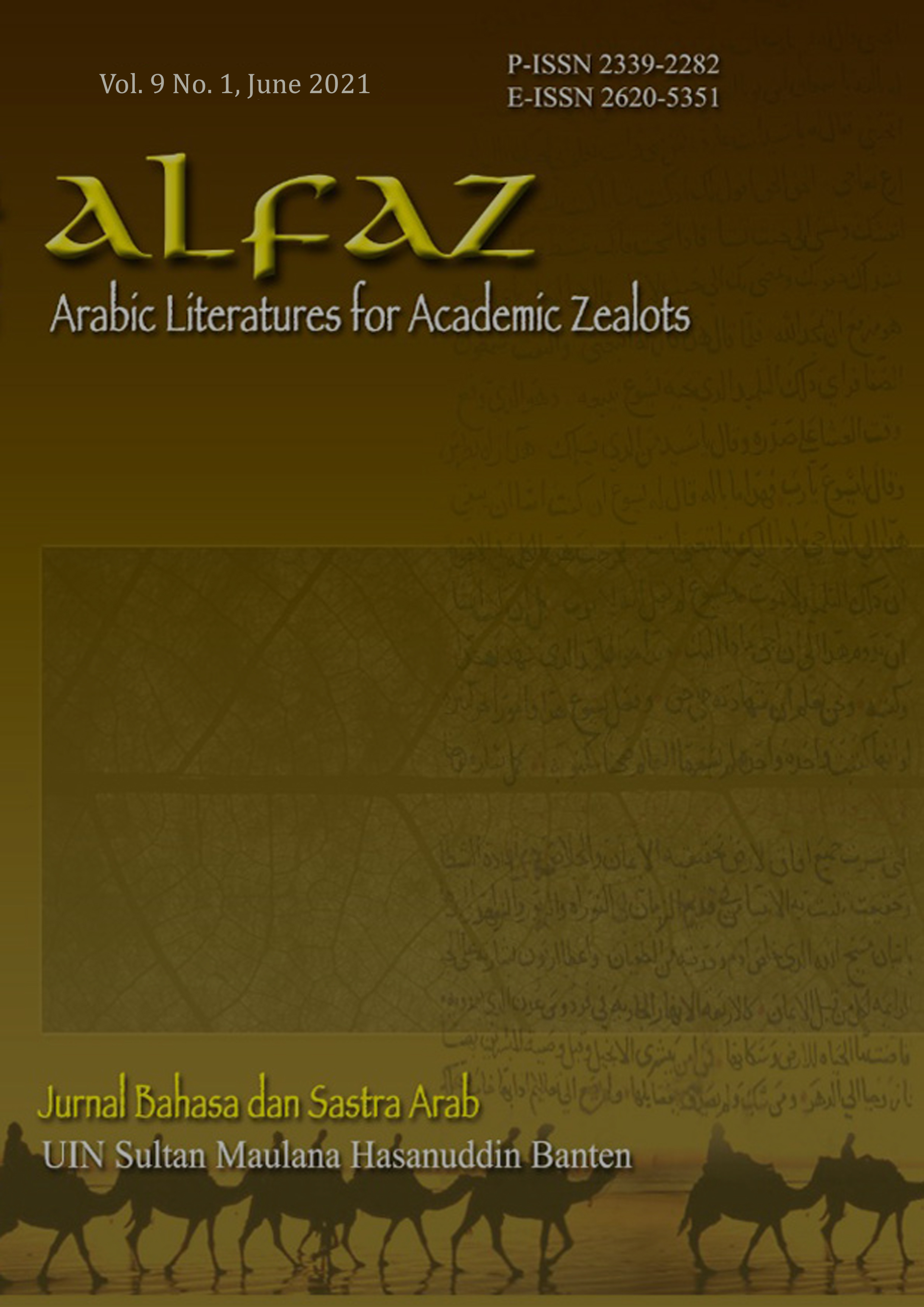Perbandingan Bahasa Antara Modern Standard Arabic Dengan Aksen Lebanon
DOI:
https://doi.org/10.32678/alfaz.Vol9.Iss1.4175Keywords:
Modern Standart Arabic, Amiyah, Arabic Language, Lebanese AccentAbstract
This study aims to determine the dialect comparison between Lebanese Arabic (colloquial Arabic) and Fusha Arabic (modern standard Arabic/MSA) so that it can add insight and knowledge about dialect Arabic. This study uses a qualitative descriptive method with a library approach in revealing differences in pronunciation in Fusha Arabic and Lebanese dialects. The results of this study indicate that there are several differences in phonological variations in the pronunciation of Arabic vocabulary. [1] There is a strengthening of the vocabulary sound from أنت (anta) to أنت (enta). [2] The existence of Lenisi as in the wordمعلم becomes معلم . [3] There is a monophthongization of يوم(yauma) to يوم(youma). [4] There is a sound dating as in the word وجه(Wajhu) to وج(wejj). [5] Merging 2 words into one as in the word كيف حالك (kaifa haluka) becomes كيفك(kiifak). [6] The use of French loanwords such as the word بونجور(Bonjur).
Downloads
References
Adib, Khoirul. Bahasa Arab Dalam Khazanah Budaya Nusantara: Perspektif Historis Dan Kontribusinya Dalam Rekayasa Budaya Nasional. Penerbit Universitas Negeri Malang, 2009.
Aziz, Abd. “LANDASAN PIKIR PERDEBATAN EKSISTENSI BAHASA ARAB FUSHA DAN ‘AMMIYYAH,” n.d., 13.
CHAIRUL FADLI, S. PD I. “PEMBELAJARAN BAHASA ARAB DI PONDOK PESANTREN MODERN DAN PESANTREN TRADISIONAL (STUDY KOMPARATIF ANTARA PONDOK PESANTREN AS’AD DAN PONDOK PESANTREN SA’ADATUDDARAIN KOTA JAMBI).” Masters, UIN SUNAN KALIJAGA YOGYAKARTA, 2015. http://digilib.uin-suka.ac.id/17463/.
Chaiyanara, Paitoon M. “Teori Fonem,” December 14, 2010. http://repository.usu.ac.id/handle/123456789/21289.
“Dialek Dalam Bahasa Arab – IAI DALWA.” Accessed January 30, 2021. https://www.iaidalwa.ac.id/dialek-dalam-bahasa-arab/.
Fithriyah, Sitie, Muhammad Irfan Fathurrahman, and Rika Astari. “Variasi Fonologis Kosakata Bahasa Arab: Bahasa Arab Fushā Dengan Bahasa Arab Maroko.” Al-Ta’rib: Jurnal Ilmiah Program Studi Pendidikan Bahasa Arab IAIN Palangka Raya 8, no. 1 (2020): 65–76.
Fithriyyahni, Azizah. “Bahasa Arab Fusha Dan ‘Ammiyah Serta Cakupan Penggunaannya,” 2018.
responsibletravel.com. “Historical Sites in Lebanon.” Accessed January 31, 2021. https://www.responsibletravel.com/holidays/lebanon/travel-guide/historical-sites.
Isnaini, Rohmatun Lukluk. “Revitalisasi Peran Bahasa Arab Untuk Mengatasi Konflik Dalam Perspektif Multikultural.” Jurnal Pembangunan Pendidikan: Fondasi Dan Aplikasi 6, no. 1 (2018): 15–26.
“Keberkahan Bumi Syam | Almanhaj,” December 19, 2017. https://almanhaj.or.id/8104-keberkahan-bumi-syam-2.html.
Kementerian Luar Negeri Repulik Indonesia. “KEDUTAAN BESAR REPUBLIK INDONESIA di BEIRUT, REPUBLIK LEBANON.” Accessed January 30, 2021. https://kemlu.go.id/beirut/id.
Khoury Aouad Saliby, Christel, Christophe Dos Santos, Edith Kouba Hreich, and Camille Messarra. “Assessing Lebanese Bilingual Children: The Use of Cross-Linguistic Lexical Tasks in Lebanese Arabic.” Clinical Linguistics & Phonetics 31, no. 11–12 (2017): 874–92.
Koesyono, Eleine. “Kehadiran Perancis Di Libanon: Sebuah Kajian Sejarah,” 1996.
Kridalaksana, Harimurti. Kamus Linguistik (Edisi Keempat). Gramedia Pustaka Utama, 2013.
Arabic with Angela. “Levantine Spoken Arabic.” Accessed January 30, 2021. https://www.learningarabicwithangela.com/levantine-spoken-arabic.
Mainora, Leni. “Analisis Perubahan Bunyi Bahasa dalam Esai Pemelajar BIPA Timor Leste,” n.d., 16.
Mufrodi, Mufrodi. “FONOLOGI DAN MORFOLOGI BAHASA ARAB’AMIYAH MESIR.” Arabiyat: Jurnal Pendidikan Bahasa Arab Dan Kebahasaaraban 2, no. 2 (2015): 192–215.
NORKHALEEDA BT ABAS. “HADITS TENTANG KEUTAMAAN NEGERI SYAM (TELA’AH MAANI AL-HADITS).” Skripsi, Universitas Islam Negeri Sultan Syarif Kasim Riau, 2017. https://doi.org/10/10.%20BAB%20V.pdf.
NUR FADLY HERMAWAN, NIM 1320412143. “PERKEMBANGAN LEMBAGA KURSUS BAHASA ARAB DI PARE KEDIRI (Kajian Historis Di Lembaga Kursus Bahasa Arab Di Pare Kediri Tahun 1996-2014).” Masters, UIN SUNAN KALIJAGA, 2015. http://digilib.uin-suka.ac.id/15992/.
Nurkholis, Nurkholis. “METODE PEMBELAJARAN BAHASA ARAB DI PONDOK PESANTREN TRADISIONAL.” An Nabighoh Jurnal Pendidikan dan Pembelajaran Bahasa Arab 19, no. 2 (January 1, 2018): 249. https://doi.org/10.32332/an-nabighoh.v19i2.1002.
Planet, Lonely. “History in Lebanon.” Lonely Planet. Accessed January 30, 2021. https://www.lonelyplanet.com/lebanon/background/history/a/nar/d46ad734-dbfb-4e7d-91a7-7d45ca6073e7/361092.
Setiyadi, Alif Cahya. “Dialek Bahasa Arab Tinjauan Dialektologis.” At-Ta’dib 6, no. 1 (2011).
Susiawati, Wati. “Kajian Bahasa Arab Dari A Historis Hingga Historis.” Alfaz (Arabic Literatures for Academic Zealots) 7, no. 01 (2019): 43–54.
WULANDARI, RINDYANI PUTRI. “Urgensi Bahasa Arab,” 2019.
Downloads
Published
Issue
Section
License
Authors retain copyright and grant the journal right of first publication with the work simultaneously licensed under a CC BY NC SA License that allows others to share the work with an acknowledgement of the work's authorship and initial publication in this journal.







